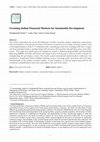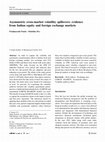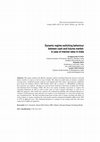Papers by Dr. Pradiptarathi Panda

Australasian accounting business and finance journal, 2024
This article summarizes the recent developments in India's securities markets regulations, instru... more This article summarizes the recent developments in India's securities markets regulations, instruments, and intermediaries. It documents the latest and first-ever initiatives in the Indian securities markets such as the implementation of the T+1 settlement cycle, introducing social stock exchange with Zero Coupon and Zero principal bonds, a stronger framework for green debt securities through blue, green, and yellow bonds. The article also dwells upon the regulations related to Business Responsibility and Sustainable Reporting (BRSR), and ESG disclosures and ratings aimed at setting up an efficient market structure by strengthening the governance system. The fourth annual international capital markets conference was organized to foreground India's multiple challenges and to encourage policy discussion about the latest developments in the Indian securities market. A brief summary of relevant papers presented in the conference and published in this issue is provided at the end of the article. 4
Australasian accounting business and finance journal, 2024
Cogent Business & Management, Sep 4, 2022

Decision, May 23, 2014
In order to capture the volatility and asymmetric transformation effect in Indian stock and forei... more In order to capture the volatility and asymmetric transformation effect in Indian stock and foreign exchange market, two exchange rates [US Dollar (USD) and Euro] were tested with stock index (SENSEX). The study focused on the 2008 US subprime financial crisis period and analyzed data for the two sub periods like pre subprime and post subprime crisis period. The whole of the study period covers from 2nd April 2004 to 30th March 2012 with total of 1,930 daily observations. Descriptive statistics were drawn from the data series to know the nature of the data. All return series were found to be stationary at level. To proceed, for examining the volatility spillover between the variables generalized autoregressive conditional heteroskedasticity (GARCH) and exponential GARCH (EGARCH) models was used. The benefit of using EGARCH model is that, it is able to capture the asymmetric nature or the impact of good and bad news separately. The inferences drawn by applying these models in the two sub periods revealed that post crisis period comprised highest bidirectional volatility and asymmetric spillover effect between these two markets compared to pre-crisis period. The study observed that unlike volatility in Euro currency, volatility in Indian stock market was more caused by volatility in USD. Likewise post crisis period is pronouncing more volatility compared to pre-crisis period. This kind of research is of higher relevance in present day context because it allows the players of the financial markets to hedge their risk accordingly.

Review of Pacific Basin Financial Markets and Policies
This study examines the nonlinear dependence and tail dependence of BRICS countries’ stock market... more This study examines the nonlinear dependence and tail dependence of BRICS countries’ stock markets and the contagion effect among Brazil, Russia, India, China, and South Africa (BRICS) countries’ daily stock markets using the COPULA model from January 2000 to February 2019. The study employs the DCC-MGARCH model and Diebold and Yilmaz volatility spillover model to assess the interdependence dynamics across BRICS countries’ stock markets. The copula results suggest that the BRICS country’s stock markets are independent of each other. The conditional correlation between BRICS is negative and statistically significant, suggesting that the negative relationship among BRICS is an important signal for international investors to diversify among these countries and get the economic value of their investment. Further, Brazil, China, and South Africa are the net volatility transmitter, at the same time India and Russia are the net volatility receiver during the study period. The study propose...

Managerial Finance
PurposeThe present study aims to verify whether there is a positive (negative) role being played ... more PurposeThe present study aims to verify whether there is a positive (negative) role being played by the institutional investors on the loss-making companies' performance.Design/methodology/approachThe authors employ panel data regression and two-step system generalised method of moments (SYS-GMM) to test the above objective.FindingsThe empirical results clearly show that no positive relation is found between institutional investors and loss-making companies' performance.Research limitations/implicationsThe findings of the study might have significant implications for firms to improve the firms' operational performance [return on assets (ROA)]. Also, the firm's financial performance [return on equity (ROE)] could be improved by increasing profitability which will reflect in the share prices of the firms whereby the performance can build the investors' confidence over the firm. Market performance (Tobin's Q) could be increased by providing more attractive offer...
Asia-Pacific Financial Markets
Management and labour studies, Apr 20, 2023

Journal of Emerging Market Finance
This study uses the MGARCH-BEKK model and Diebold–Yilmaz (DY) volatility spillover index to exami... more This study uses the MGARCH-BEKK model and Diebold–Yilmaz (DY) volatility spillover index to examine volatility spillovers among BRICS countries’ stock markets. The study finds that the own volatility spillover is more than the cross-markets and has increased during the financial crisis. In contrast, the cross-markets volatility spillovers have decreased after the financial crisis. The total net return spillover increased during the crisis period (27.30%) and the pre-crisis period (25.50%) in comparison with the post-crisis period (6.30%) and the whole sample period (10.70%). Brazil is the highest net volatility transmitter among the BRICS countries’ stock markets, and China is the highest net volatility receiver. We learned from the volatility network connectedness that China is highly connected with India regarding volatility. Foreign institutional investors may use this study’s result to find diversification opportunities across the BRICS stock markets. JEL Codes: F3, G11, G12, G15
Asia-Pacific Financial Markets
Cogent Business & Management
Theoretical and Applied Economics, 2019
Influence of corporate ownership structure on corporate performance and governance has been a mat... more Influence of corporate ownership structure on corporate performance and governance has been a matter of debate and investigation in the literature of financial performance, and financial economics. This study explores the nature and extent of the relationship between ownership category and financial performance of the firm in limited manner. It investigates as to how heterogeneity of owners as well as the ownership category of the firm, per se, impacts the corporate performance. Employing panel regression model, the results show ownership structure impacts financial performance but only selectively, and the strength of the impact appears weak. This creates a basis for further analysis to understand the incentives and examine the impact of ownership structure on corporate financial performance across the sectors and the markets.

The present study analyses the spill-over's effect between the interest rate cash and futures... more The present study analyses the spill-over's effect between the interest rate cash and futures market in India. We use daily data of volumes, weighted average price, weighted average yield to represent cash market and number of contracts traded, values, open interest, settlement price to represent futures market from 4th August 2014 to 31st December 2015 with 337(trading days) number of observations. We consider a single instrument (i.e. 08.40 GS 2024) which is most liquid, active and have contracts for a longer time period. All data are sourced from Clearing Corporation of India Ltd. (CCIL) and National Stock Exchange (NSE). We first presents descriptive statistics followed by stationarity test, Correlation, Regression, Granger Causality test and ARMA (1, 1), GARCH (1, 1) spillover'smodel. The study finds cash market price is leading the futures market but the future settlement price has impact on the yield of the underlying security.
Theoretical and Applied Economics, 2019
Influence of corporate ownership structure on corporate performance and governance has been a mat... more Influence of corporate ownership structure on corporate performance and governance has been a matter of debate and investigation in the literature of financial performance, and financial economics. This study explores the nature and extent of the relationship between ownership category and financial performance of the firm in limited manner. It investigates as to how heterogeneity of owners as well as the ownership category of the firm, per se, impacts the corporate performance. Employing panel regression model, the results show ownership structure impacts financial performance but only selectively, and the strength of the impact appears weak. This creates a basis for further analysis to understand the incentives and examine the impact of ownership structure on corporate financial performance across the sectors and the markets.

Theoretical and Applied Economics, 2017
This study examines the Markov dynamic regime switching behaviour between cash and futures market... more This study examines the Markov dynamic regime switching behaviour between cash and futures market in respect to interest rate in India. The study uses daily data of volumes, weighted average price, weighted average yield for cash market and total values, open interest, settlement price from 21st January 2014 to 30th October 2014. We a contract i.e. 883GS2023 of NSE has been used for our analysis. All data are sourced from Clearing Corporation of India Ltd. (CCIL) and National Stock Exchange (NSE). We have run regime switching regression to capture the switching behaviour in bull as well as bear state of cash to future and future to cash in six different equations. This model also captures the estimated probability and estimated duration to continue in bull and bear state and does not require to test stationarity or conversion of data into any normalised form. We find switching behaviour in both cash is regime switching the future as well as future is regime switching the cash market...
FIIB Business Review
Relative momentum strategies yield large and substantial profits in the Indian Stock Market. Neve... more Relative momentum strategies yield large and substantial profits in the Indian Stock Market. Nevertheless, relative momentum profits are negatively skewed and prone to occasional severe losses. By taking into consideration 450 stocks listed on the Bombay Stock Exchange, the present study predicts the timing of these huge momentum losses and proposes a simple risk-managed momentum approach to avoid these losses. The proposed risk-managed momentum approach not only doubles the adjusted Sharpe ratio but also results in significant improvements in downside risks. In contrast to relative momentum payoffs, risk-managed momentum payoffs remain substantial even in extended time frames. The study’s findings are particularly relevant for asset management companies, fund houses and financial academicians working in the area of asset anomalies.









Uploads
Papers by Dr. Pradiptarathi Panda